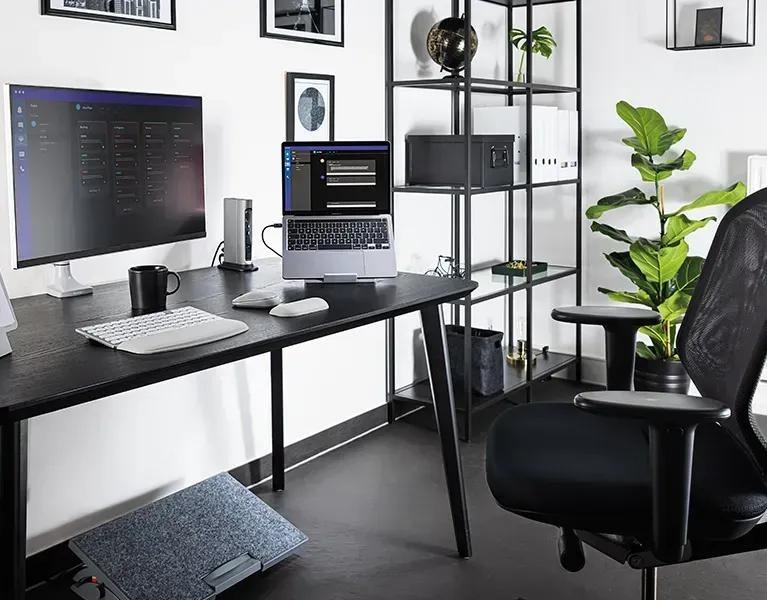Active Desk Workers With Back Pain
Discover The New Way to Bid Farewell
to Back Pain and Melt Years Off Your Body
Active Desk Workers With Back Pain
Discover The New Way to Bid Farewell
to Back Pain and Melt Years Off Your Body

In the last two decades, the concept of ergonomics has transcended from a mere buzzword to a fundamental aspect of workplace design, emphasizing the importance of adapting work environments to fit the needs of workers. As an experienced health coach and ergonomist with 15 years in physical therapy and rehabilitation.
I’ve witnessed first-hand the transformative impact of ergonomic interventions on individuals suffering from work-related musculoskeletal disorders.
This article explores the evolution of ergonomic practices with a focus on the shift from traditional office settings to remote work environments and offers evidence-based strategies to mitigate the risk of neck, back, shoulder, and hip pain among remote workers.
The Rise of Ergonomics in the Workplace
Ergonomics, or the study of people’s efficiency in their working environment, has its roots in the early 20th century but gained significant attention in the late 1990s and early 2000s with the rise of computer-related occupations. Research from the National Institute for Occupational Safety and Health highlights that ergonomic interventions can reduce the risk of musculoskeletal disorders, which account for a significant portion of worker compensation claims and productivity losses.
Transition to Remote Work: Challenges and Opportunities
The global shift towards remote work, accelerated by the COVID-19 pandemic, has introduced new challenges in maintaining ergonomic practices. A study published in the International Journal of Environmental Research and Public Health in 2020 found that remote workers are at an increased risk of MSDs due to improper work setups and prolonged sedentary behavior.
The transition away from well-equipped office environments has underscored the need for adaptable ergonomic solutions that can be implemented in diverse home settings.
Key Ergonomic Principles for Remote Work
Adapting ergonomic principles to home offices involves more than just investing in a good chair or desk. It requires a holistic approach that considers posture, equipment placement, and work habits. Based on my experience and the Stand Up Method, I recommend the following strategies:
Digital Posture Analysis
For remote workers, a digital posture analysis can provide invaluable insights into potential risk factors for MSDs. This AI-driven approach allows individuals to assess their posture and make adjustments to their work setups accordingly. By aligning technology with ergonomic principles, we can create more functional and comfortable work environments, even at home.
Dynamic Workstations
The concept of dynamic workstations, including sit-stand desks and ergonomic chairs, plays a crucial role in mitigating the risks associated with prolonged sitting. A meta-analysis published in the Annals of Internal Medicine suggests that alternating between sitting and standing can reduce back pain and improve posture over time.
Ergonomic Accessories
Incorporating ergonomic accessories, such as keyboard trays, monitor stands, and footrests, can further enhance the remote work experience. These tools help maintain neutral body positions, reducing the strain on the neck, back, and shoulders. Ergonomic accessories are essential for creating an adaptable and health-conscious home office.
Implementing Ergonomic Practices: A Step-by-Step Guide
1. Assessment: Begin with a digital posture analysis to identify any existing issues or potential risks.
2. Equipment Selection: Invest in ergonomic furniture and accessories that support a neutral body posture.
3. Environment Setup: Arrange your workspace to ensure that monitors are at eye level, keyboards are within easy reach, and there is sufficient space to change positions comfortably.
4. Behavioral Changes: Incorporate regular breaks, stretching exercises, and alternating work positions throughout the day to reduce sedentary behavior.
Conclusion
The evolution of ergonomic practices from traditional office settings to remote work environments reflects the changing nature of work in the 21st century.
By embracing a holistic approach that combines technology, ergonomic furniture, and health-conscious work habits, remote workers can create sustainable and comfortable workspaces that support their physical well-being.
As we continue to navigate the challenges and opportunities presented by remote work, we must prioritize ergonomics not as an afterthought but as a fundamental aspect of our daily work lives.
By doing so, we can prevent the onset of MSDs and enhance our overall quality of life, proving once again that when it comes to health and productivity, the best approach is a proactive one.
About Michael Jones, MS, CErg
Michael Jones is an Author and ergonomist with over 15 years of practical experience in physical therapy and rehabilitation. He shares tips and videos with his 15k followers on Instagram. He is the author of Stand Up! Upgrade Your Posture…Transform Your Life.
Are you ready to upgrade the way you work? Email me painfreeme2017 at gmail.com
Instagram
LinkedIn
Youtube